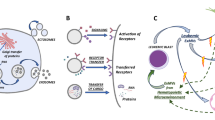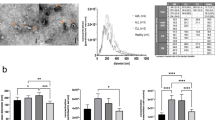Abstract
Macropinocytosis serves as an internalization pathway for extracellular fluid and its contents. Macropinocytosis is upregulated in oncogene-expressing cells and, recently, we have revealed a functional role for macropinocytosis in fueling cancer cell growth through the internalization of extracellular albumin, which is degraded into a usable source of intracellular amino acids. Assessing macropinocytosis has been challenging in the past because of the lack of reliable assays capable of quantitatively measuring this uptake mechanism. Here we describe a protocol for visualizing and quantifying the extent of macropinocytosis in cells both in culture and growing in vivo as tumor xenografts. By using this approach, the 'macropinocytic index' of a particular cell line or subcutaneous tumor can be ascertained within 1–2 d. The protocol can be carried out with multiple samples in parallel and can be easily adapted for a variety of cell types and xenograft or allograft mouse models.
This is a preview of subscription content, access via your institution
Access options
Subscribe to this journal
Receive 12 print issues and online access
$259.00 per year
only $21.58 per issue
Buy this article
- Purchase on Springer Link
- Instant access to full article PDF
Prices may be subject to local taxes which are calculated during checkout


Similar content being viewed by others
References
Khalil, I.A., Kogure, K., Akita, H. & Harashima, H. Uptake pathways and subsequent intracellular trafficking in nonviral gene delivery. Pharmacol. Rev. 58, 32–45 (2006).
Norbury, C.C. Drinking a lot is good for dendritic cells. Immunology 117, 443–451 (2006).
Mercer, J. & Helenius, A. Virus entry by macropinocytosis. Nat. Cell Biol. 11, 510–520 (2009).
Finlay, B.B. & Cossart, P. Exploitation of mammalian host cell functions by bacterial pathogens. Science 276, 718–725 (1997).
Bar-Sagi, D. & Feramisco, J.R. Induction of membrane ruffling and fluid-phase pinocytosis in quiescent fibroblasts by ras proteins. Science 233, 1061–1068 (1986).
Kasahara, K. et al. Role of Src-family kinases in formation and trafficking of macropinosomes. J. Cell Physiol. 211, 220–232 (2007).
Mettlen, M. et al. Src triggers circular ruffling and macropinocytosis at the apical surface of polarized MDCK cells. Traffic 7, 589–603 (2006).
Veithen, A., Cupers, P., Baudhuin, P. & Courtoy, P.J. v-Src induces constitutive macropinocytosis in rat fibroblasts. J. Cell Sci. 109 (Pt 8): 2005–2012 (1996).
Commisso, C. et al. Macropinocytosis of protein is an amino acid supply route in Ras-transformed cells. Nature 497, 633–637 (2013).
Hillaireau, H. & Couvreur, P. Nanocarriers' entry into the cell: relevance to drug delivery. Cell Mol. Life Sci. 66, 2873–2896 (2009).
Jones, A.T. Macropinocytosis: searching for an endocytic identity and role in the uptake of cell penetrating peptides. J. Cell Mol. Med. 11, 670–684 (2007).
Redelman-Sidi, G., Iyer, G., Solit, D.B. & Glickman, M.S. Oncogenic activation of Pak1-dependent pathway of macropinocytosis determines BCG entry into bladder cancer cells. Cancer Res. 73, 1156–1167 (2013).
Haga, Y., Miwa, N., Jahangeer, S., Okada, T. & Nakamura, S. CtBP1/BARS is an activator of phospholipase D1 necessary for agonist-induced macropinocytosis. EMBO J. 28, 1197–1207 (2009).
Wang, J.T. et al. The SNX-PX-BAR family in macropinocytosis: the regulation of macropinosome formation by SNX-PX-BAR proteins. PLoS ONE 5, e13763.
Yoshida, S., Hoppe, A.D., Araki, N. & Swanson, J.A. Sequential signaling in plasma-membrane domains during macropinosome formation in macrophages. J. Cell Sci. 122, 3250–3261 (2009).
Steinman, R.M. & Cohn, Z.A. The interaction of soluble horseradish peroxidase with mouse peritoneal macrophages in vitro. J. Cell Biol. 55, 186–204 (1972).
Cupers, P., Veithen, A., Kiss, A., Baudhuin, P. & Courtoy, P.J. Clathrin polymerization is not required for bulk-phase endocytosis in rat fetal fibroblasts. J. Cell Biol. 127, 725–735 (1994).
Mercer, J. & Helenius, A. Vaccinia virus uses macropinocytosis and apoptotic mimicry to enter host cells. Science 320, 531–535 (2008).
Punnonen, E.L., Ryhanen, K. & Marjomaki, V.S. At reduced temperature, endocytic membrane traffic is blocked in multivesicular carrier endosomes in rat cardiac myocytes. Eur. J. Cell Biol. 75, 344–352 (1998).
Murphy, R.F., Powers, S. & Cantor, C.R. Endosome pH measured in single cells by dual fluorescence flow cytometry: rapid acidification of insulin to pH 6. J. Cell Biol. 98, 1757–1762 (1984).
Kerr, M.C. & Teasdale, R.D. Defining macropinocytosis. Traffic 10, 364–371 (2009).
Berthiaume, E.P., Medina, C. & Swanson, J.A. Molecular size-fractionation during endocytosis in macrophages. J. Cell Biol. 129, 989–998 (1995).
Kim, M.P. et al. Generation of orthotopic and heterotopic human pancreatic cancer xenografts in immunodeficient mice. Nat. Protoc. 4, 1670–1680 (2009).
Koivusalo, M. et al. Amiloride inhibits macropinocytosis by lowering submembranous pH and preventing Rac1 and Cdc42 signaling. J. Cell Biol. 188, 547–563 (2010).
Ivanov, A.I. Pharmacological inhibition of endocytic pathways: is it specific enough to be useful? Methods Mol. Biol. 440, 15–33 (2008).
Weigert, R. & Donaldson, J.G. Fluorescent microscopy-based assays to study the role of Rab22a in clathrin-independent endocytosis. Methods Enzymol. 403, 243–253 (2005).
Lee, C. & Tannock, I. Pharmacokinetic studies of amiloride and its analogs using reversed-phase high-performance liquid chromatography. J. Chromatogr. B Biomed. Appl. 685, 151–157 (1996).
Morton, C.L. & Houghton, P.J. Establishment of human tumor xenografts in immunodeficient mice. Nat. Protoc. 2, 247–250 (2007).
Aleksandrowicz, P. et al. Ebola virus enters host cells by macropinocytosis and clathrin-mediated endocytosis. J. Infect. Dis. 204 (suppl. 3): S957–S967 (2011).
Acknowledgements
We are grateful to members of the Bar-Sagi laboratory for their comments and discussions. This work was supported by US National Institutes of Health (NIH) grant no. R01CA055360 to D.B.-S. C.C. was supported by a Canadian Institutes of Health Research postdoctoral fellowship and an American Association for Cancer Research postdoctoral fellowship provided by the Pancreatic Cancer Action Network. R.J.F. was supported by a NIH NCI NRSA F32 Individual Fellowship F32CA171877. All animal care and procedures were approved by the Institutional Animal Care and Use Committee at New York University (NYU) School of Medicine. The Histopathology Core of NYU School of Medicine is partially supported by the NIH (grant no. 5 P30CA016087-32). Troma I, an antibody that recognizes CK8, was contributed by P. Brulet and R. Kemler and made available by the Developmental Studies Hybridoma Bank under the auspices of the Eunice Kennedy Shriver National Institute of Child Health and Human Development.
Author information
Authors and Affiliations
Contributions
C.C., R.J.F. and D.B.-S. contributed to the experimental design. C.C. performed the experiments and data analysis. C.C., R.J.F. and D.B.-S. wrote the manuscript.
Corresponding authors
Ethics declarations
Competing interests
The authors declare no competing financial interests.
Rights and permissions
About this article
Cite this article
Commisso, C., Flinn, R. & Bar-Sagi, D. Determining the macropinocytic index of cells through a quantitative image-based assay. Nat Protoc 9, 182–192 (2014). https://doi.org/10.1038/nprot.2014.004
Published:
Issue Date:
DOI: https://doi.org/10.1038/nprot.2014.004
This article is cited by
-
Nutrient uptake strategies shift during mouse epiblast development
Nature Metabolism (2024)
-
Novel method of measurement of in vitro drug uptake in OATP1B3 overexpressing cells in the presence of dextran
Pharmacological Reports (2024)
-
Activation of invasion by oncogenic reprogramming of cholesterol metabolism via increased NPC1 expression and macropinocytosis
Oncogene (2023)
-
Cellular mechanisms of heterogeneity in NF2-mutant schwannoma
Nature Communications (2023)
-
Macropinocytosis is an alternative pathway of cysteine acquisition and mitigates sorafenib-induced ferroptosis in hepatocellular carcinoma
Journal of Experimental & Clinical Cancer Research (2022)
Comments
By submitting a comment you agree to abide by our Terms and Community Guidelines. If you find something abusive or that does not comply with our terms or guidelines please flag it as inappropriate.



